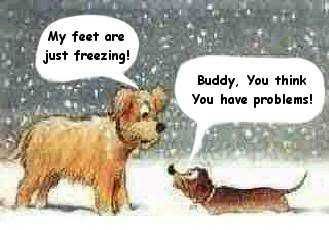 Well, not yet exactly. As I'm typing this, it's still in the balmy 50's. BUT, by noon today, our temps are supposed to plummet, thanks to an approaching winter storm. We are only supposed to benefit from the outer fringes of the storm, but we are supposed to have SNOW by late afternoon, tonight, and maybe a few flurries tomorrow morning!! It's not supposed to amount to much, but it will still be nice to see the flakes floating down from the sky. We had snow last Sunday, and it was so exciting. It keeps trying very hard to snow on us this winter, so I'm just sure, that soon we'll have a whopper of a snow, before winter's done.
Well, not yet exactly. As I'm typing this, it's still in the balmy 50's. BUT, by noon today, our temps are supposed to plummet, thanks to an approaching winter storm. We are only supposed to benefit from the outer fringes of the storm, but we are supposed to have SNOW by late afternoon, tonight, and maybe a few flurries tomorrow morning!! It's not supposed to amount to much, but it will still be nice to see the flakes floating down from the sky. We had snow last Sunday, and it was so exciting. It keeps trying very hard to snow on us this winter, so I'm just sure, that soon we'll have a whopper of a snow, before winter's done. Yesterday while doing my daily blog read at Warm Puppies, I discovered a link to a wonderful new blog. It's called, ANIMALS are HUMANS too!. It's quite an interesting blog with several, probably over 20, contributors. They are currently accepting new contributors, so I signed up to post over there occassionally. So lope on over there and have a look. Tell Thess and the other contributors hello! Also, while on Warm Puppies, I ready Chrissy's WONDERFUL rescue story!! It was so touching, I found myself looking for a Kleenex afterwards. I recommend that everyone go and have a look at a wonderful rescuer's story, but be sure to have plenty of tissues.

Since it seems I'm obsessed with winter weather this year, I thought I'd post some winter weather tips for our furry friends. Always remember to follow this advice to keep your pets happy, healthy, and warm this winter.... Everyone have a fabulous weekend!

Cold-Weather Concerns -- 15 Warming TipsYou know it's getting cold when your furry Persian won't leave her perch beside the stove and your woolly sheepdog looks like he'd appreciate an extra coat.
While dogs and cats are never really underdressed -- they wear their favorite furs year-round -- Jack Frost's nip can still give a painful bite.
Without protection from the elements, dogs and cats can develop frostbite or hypothermia -- a potentially deadly condition that may occur if their temperature drops even a few degrees. At the very least they can be cold and miserable -- or even have ice balls form between their toes.
With a few simple precautions you can keep your pets cozy no matter what winter throws your way -- and even save their lives should they accidentally spend too much time in the bitter cold.
For Dogs and Cats
Consider his background.
Not all pets are equally at home in the cold. While a Labrador or sheepdog might be comfortable outside on all but the coldest days, a miniature poodle or short-haired cat might get chilly even when it's balmy, says Tom Bradley, owner of Luftnase Kennel in Watertown, New York. Check with your vet if you're not sure if your pet is bred for chilly climes. If he's not, you'll want to keep him where it's warm -- in the house, garage or a comfortable outbuilding.
Check his wardrobe.
While most cats are comfortable in the cold, "only dogs that grow thick coats can really stay outdoors," Bradley says. "My Labradors, it doesn't matter what the weather is. They go out and play in the snow. My German short-haired pointers, on the other hand, go out, do what they have to do and then come in and get underneath the woodstove." Keep his hair combed.
"If your animal grows a thick hair coat for the winter, you want to make sure it doesn't get matted," says Kenneth Sperling, D.V.M., a veterinarian in private practice in Anchorage, Alaska. "Wet, matted hair can lead to diseases of the skin because the dead hair traps dirt and debris." Lend him something warm.
On particularly cold days, your pet may appreciate being bundled up before he goes outdoors. This is especially true of breeds such as toy poodles, which typically have thin coats and aren't well-suited for the cold. "Dog sweaters are perfectly fine," says Dr. Sperling. Give him time to adjust.
After spending a nice sunny season warming himself in the yard, your pet may not be prepared for winter's chill. It usually takes between three and six weeks after the temperature drops before your pet's winter coat gets thick enough to stave off winter's chill, says Mark Raffe, D.V.M., professor of anesthesiology and critical care at the University of Minnesota College of Veterinary Medicine in St. Paul. "Allow the pet to slowly adapt to the environment," he says. "Give him progressive periods outside, starting with 15 minutes a day."
Do your share of skin care.
Winter air can be extremely drying, and even pets that never set a paw outdoors can get dry, itchy skin, says Dr. Sperling. To prevent this, he recommends giving all pets a B-complex vitamin that contains fatty acids, which will help keep their skin from drying out. Give him shelter.
Watch the wind-chill. Even if the thermometer reads a relatively comfy 25?, a breeze can make it feel a heck of a lot colder. "With the wind-chill factor it could feel like 25 below," says Dr. Sperling, so be prepared to bring your pet in when it's blowing. Listen to his appetite.
If your pet lives outdoors, he'll burn up a lot more calories in the winter just trying to stay warm. If your dog spends a lot of time outdoors, "you may need to increase his calorie intake by 25 to 50 percent," says Dr. Raffe. "They need those extra calories not only for energy demands but also to get a thicker coat."
Keep the water bowl full -- and fluid.
When the temperature drops, water freezes. "An animal can go for only 20 hours without water before becoming dehydrated," warns Dr. Sperling. He recommends providing fresh water frequently throughout the day to keep the water bowl full. Or you can buy an electric warming device that will keep the water liquid on even the coldest days. "Just be careful not to run an electrical cord where the animal can chew it," he adds.
Trim around the toes.
While many dogs and cats love romping through the snow, they'll occasionally develop small ice balls between their toes that can lead to frostbitten feet. "You should regularly trim out the long hair between the foot pads so it doesn't become the focus for ice-ball formation," says Dr. Raffe. Turn on the heat.
If your pet already has ice balls between his toes, you can melt them quickly with a hair dryer, says Ronald Stone, D.V.M., clinical assistant professor of surgery at the University of Miami School of Veterinary Medicine and national executive secretary of the American Association of Pet Industry Veterinarians. Hold the dryer about six inches away and keep it moving until all the ice is melted. "Just keep it on a low setting so you don't burn them," he warns.
Look for damage.
While you're doing the pet-icure, check to see if ice has scraped or cut the pads. If it has, apply a little first aid ointment containing an antiseptic to help prevent infection. Then rub on a little hand lotion or aloe vera to keep the pads soft, he says.
For Cats Only
Do an engine check. During the cold months many outdoor cats will creep into the engine compartment of cars to take advantage of the "central heating" -- and then get hurt when someone turns the key. Before starting the car in the morning, you may want to check under the hood for visitors, vets advise. It takes only a minute and could save your pet's life.
When to See the Vet
If your pet has been outside too long and you suspect he has frostbite -- symptoms commonly include flushing, swelling and itching of the affected part -- rub him gently with a blanket or your hands to gradually raise the temperature of the frozen parts. "Don't do a lot of rubbing or you'll cause more damage," says Kenneth Sperling, D.V.M., a veterinarian in private practice in Anchorage, Alaska. Frostbite is serious, so you'll want to get your pet to the vet as soon as possible, he adds.
The same advice applies if you suspect your pet has developed hypothermia, or low body temperature, which can cause shallow breathing, a weak pulse or shivering muscles. (If he's not shivering, however, it could mean that your pet has suffered severe exposure to cold and that his metabolism isn't capable of spontaneously increasing body temperature.) "You need to bring him into a warm environment and slowly allow him to rewarm," advises Robert J. Murtaugh, D.V.M., associate professor in the Department of Medicine at the Tufts University School of Veterinary Medicine in North Grafton, Massachusetts.
But avoid using the heat from lamps, heating pads or open ovens, because your pet could be burned. Instead, wrap him in a warm blanket and hold him close so your body temperature will help raise his. Then get him to the vet as soon as you can.



























No comments:
Post a Comment